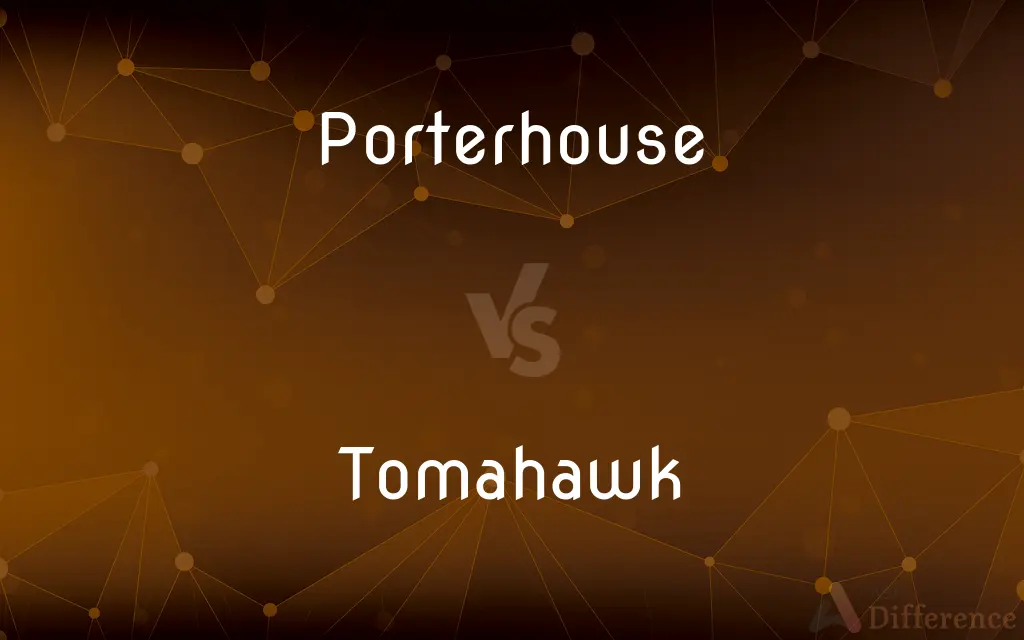Porterhouse vs. Tomahawk — What's the Difference?
Edited by Tayyaba Rehman — By Fiza Rafique — Published on December 25, 2023
Porterhouse is a large steak cut from the rear of the short loin, containing both tenderloin and top loin. Tomahawk, resembling an axe, is a ribeye steak attached to a long bone. Both are prime cuts, but they differ in bone structure and muscle content.

Difference Between Porterhouse and Tomahawk
Table of Contents
ADVERTISEMENT
Key Differences
Porterhouse steaks are known for their generous size and the unique characteristic of combining two prized cuts of beef in one: the tenderloin and the top loin (or New York Strip). Located at the rear end of the short loin, the Porterhouse includes a larger portion of the tenderloin compared to its close relative, the T-bone steak. This dual-texture quality makes the Porterhouse particularly desirable among steak enthusiasts, offering the buttery tenderness of the tenderloin on one side and the flavorful chewiness of the top loin on the other. When cooked, the Porterhouse steak promises a luxurious dining experience.
In contrast, the Tomahawk steak stands out primarily because of its dramatic presentation. This cut is essentially a ribeye steak with a long section of the rib bone still attached, giving it the appearance of a single-handed axe or tomahawk, hence its name. The Tomahawk's bone isn't just for show; it adds flavor during the cooking process. Ribeye, being one of the more marbled cuts, ensures that the Tomahawk steak is rich in flavor, juicy, and tender.
While both the Porterhouse and Tomahawk are among the higher-end cuts of beef, their culinary applications can differ slightly. The Porterhouse, due to its combination of two distinct muscle groups, requires careful cooking to ensure both the tenderloin and top loin reach their ideal doneness. On the other hand, the Tomahawk, with its extended bone, often benefits from reverse-searing or grilling, which allows the meat to cook evenly while also achieving a flavorful crust.
Price-wise, both the Porterhouse and Tomahawk tend to be on the more expensive side due to their size and quality. However, the exact cost can vary depending on factors such as the beef's grade, its origin, and where it's purchased. But whether you're enjoying a Porterhouse or a Tomahawk, both cuts represent the pinnacle of steak dining, promising a memorable culinary experience.
Comparison Chart
Part of Beef
Rear end of the short loin
Rib section
ADVERTISEMENT
Contains
Tenderloin and top loin
Ribeye meat
Bone
T-shaped bone
Long rib bone
Associated Cuts
Similar to T-bone but with larger tenderloin
Essentially a ribeye with bone
Cooking Consideration
Ensure both tenderloin and top loin cook properly
Benefits from reverse-searing or grilling
Compare with Definitions
Porterhouse
A steak cut from the rear of the short loin.
The chef recommended the Porterhouse for its dual texture.
Tomahawk
Resembles a single-handed axe in appearance.
The name Tomahawk is apt given the steak's axe-like shape.
Porterhouse
Contains both tenderloin and top loin meats.
The Porterhouse steak offers the best of both worlds: tenderloin and top loin.
Tomahawk
Benefits from grilling or reverse-searing methods.
To get the best out of your Tomahawk, try the reverse-searing method.
Porterhouse
Larger version of the T-bone steak.
For a meatier option, choose the Porterhouse over the T-bone.
Tomahawk
Known for its rich marbling and flavor.
If you're after a flavorful steak, the Tomahawk won't disappoint.
Porterhouse
A luxurious choice among steak cuts.
For our anniversary, we splurged on a Porterhouse steak.
Tomahawk
A ribeye steak with a long section of rib bone attached.
The Tomahawk steak looked impressive on the grill with its long bone.
Porterhouse
Recognized by its T-shaped bone.
The distinguishing T-bone in the center makes the Porterhouse easy to identify.
Tomahawk
Often large enough to serve multiple people.
The sheer size of the Tomahawk makes it perfect for sharing.
Porterhouse
A cut of beef taken from the thick end of the short loin, having a T-bone and a sizable piece of tenderloin. Also called porterhouse steak.
Tomahawk
A light axe formerly used as a tool or weapon by certain Native American peoples.
Porterhouse
A cut of meat, especially pork, taken from the corresponding part of another mammal.
Tomahawk
A similar implement or weapon.
Porterhouse
(Archaic) An alehouse or chophouse.
Tomahawk
To strike with or as if with a tomahawk.
Porterhouse
A cut of beef taken from the thick end of the short loin; it has a T-shaped bone and a large piece of tenderloin; a porterhouse steak.
Tomahawk
An ax used by Native American warriors.
Porterhouse
A public house where porter was sold; often also served steaks, chops etc.
Tomahawk
(basketball) A dunk performed with one's arm behind one's head.
Porterhouse
A house where porter is sold.
Tomahawk
(geometry) A geometric construction consisting of a semicircle and two line segments that serves as a tool for trisecting an angle; so called from its resemblance to the American Indian axe.
Porterhouse
Large steak from the thick end of the short loin containing a T-shaped bone and large piece of tenderloin
Tomahawk
(field hockey) A field hockey shot style that involves a player turning their hockey stick upside-down and swinging it so that its inside edge will come into contact with the ball.
Tomahawk
To strike or cut up with a tomahawk.
Tomahawk
(historical) To girdle or incise the trees around (an area of land) so as to claim ownership of it.
Tomahawk
(basketball) To perform a tomahawk dunk.
Tomahawk
A kind of war hatchet used by the American Indians. It was originally made of stone, but afterwards of iron.
Tomahawk
To cut, strike, or kill, with a tomahawk.
Tomahawk
Weapon consisting of a fighting ax; used by North American indians
Tomahawk
Cut with a tomahawk
Tomahawk
Kill with a tomahawk
Common Curiosities
Why is the Tomahawk steak also called an axe steak?
Because of its long bone, it resembles a tomahawk or axe.
Is the T-bone steak the same as the Porterhouse?
No, but they are similar; the Porterhouse has a larger section of tenderloin.
Is the bone in a Tomahawk steak just for presentation?
While it adds to the presentation, the bone also imparts flavor during cooking.
What part of the cow is the Tomahawk steak from?
The Tomahawk is from the rib section of the cow.
Which steak has a T-shaped bone?
The Porterhouse has a T-shaped bone.
Does the Porterhouse contain tenderloin?
Yes, the Porterhouse contains both tenderloin and top loin.
How should you cook a Tomahawk for the best flavor?
Grilling or reverse-searing is recommended for the Tomahawk.
Are both steaks typically expensive?
Yes, both the Porterhouse and Tomahawk are considered premium cuts and tend to be pricier.
How can I tell the difference between a Porterhouse and a T-bone?
Check the size of the tenderloin; a Porterhouse has a larger tenderloin section.
Which steak is known for having two types of meat textures?
The Porterhouse offers two textures: tenderloin and top loin.
How long should a Tomahawk steak be grilled?
It depends on its thickness and desired doneness, but often around 20-30 minutes per side for medium-rare.
Can the Porterhouse be used in a steak sandwich?
Yes, but due to its premium quality, it's often enjoyed as a main course.
Why is the Porterhouse sometimes called the "king of steaks"?
Due to its generous size and combination of two prized cuts.
How thick is a typical Tomahawk steak?
It can vary, but many are around 2 inches thick.
What's the ideal way to season a Tomahawk?
Salt, pepper, and garlic are classic, but it depends on personal preference.
Share Your Discovery

Previous Comparison
Intermolecular Forces vs. Intramolecular Forces
Next Comparison
Reducing Agent vs. Oxidizing AgentAuthor Spotlight
Written by
Fiza RafiqueFiza Rafique is a skilled content writer at AskDifference.com, where she meticulously refines and enhances written pieces. Drawing from her vast editorial expertise, Fiza ensures clarity, accuracy, and precision in every article. Passionate about language, she continually seeks to elevate the quality of content for readers worldwide.
Edited by
Tayyaba RehmanTayyaba Rehman is a distinguished writer, currently serving as a primary contributor to askdifference.com. As a researcher in semantics and etymology, Tayyaba's passion for the complexity of languages and their distinctions has found a perfect home on the platform. Tayyaba delves into the intricacies of language, distinguishing between commonly confused words and phrases, thereby providing clarity for readers worldwide.














































